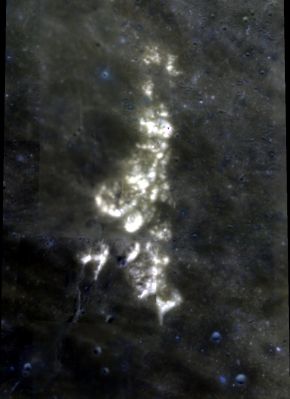Montes Spitzbergen
Contents
[hide]Spitzbergen Mountains/ Montes Spitzbergensis
(discontinued IAU names; current IAU name: Montes Spitzbergen)
|
Lat: 35.0°N, Long: 5.0°W, Diam: 60 km, Height: 1.4 km, Rükl: 12 |
Images
LPOD Photo Gallery Lunar Orbiter Images Apollo Images
Maps
(LAC zone 25D3) LAC map Geologic map
Description
Description: Wikipedia
Additional Information
- Height data from Kurt Fisher database
- Viscardy, 1985: 1.4 km
- Cherrington, 1969: 1.4 km
- Several of the peaks were measured, as was the height of the wrinkle ridge passing to the west of the mountains. The information was published by Steve Boint in the Summer 2007 issue of Selenology: Journal of the American Lunar Society selenologysummer07a. - fatastronomer
Nomenclature
- The IAU name is German for "sharp peaks", and was named for the formations resemblance to the terrestrial island group by Mary Blagg in Named Lunar Formations (1935) (Whitaker, p. 229). Much earlier, by Johann Schröter had labeled the formation Kirch.
- The Spitzbergen mountains are said to have been informally known as the Flock of Sheep by "Santa Barbara variable star lover" Hugh G. Boutell (Copeland, 1953). Research: - DannyCaes Feb 22, 2008
- Sometimes called Montes Spitzbergensis, as on Chart 18 in the Times Atlas of the Moon, and also on SLC section D2 (System of Lunar Craters, 1966).
- On that same chart (Chart 18 in the Times Atlas), the individual peaks of these mountains received Greek letter designations. From north to south: Mu, Kappa, Epsilon, Beta, Theta, Gamma, and Alpha. On SLC D2 however, peak Theta was called Delta.
Jan Mayen
- Piton Gamma, the J-shaped hillock or island north-northeast of Montes Spitzbergen and south-southwest of Mons Piton, is unofficially called Jan Mayen by Danny Caes. The terrestrial island Jan Mayen is also located near the Spitzbergen group (Svalbard). - DannyCaes Feb 22, 2008
LPOD Articles
A Steep Spot on the Moon No Fooling
Bibliography
Harold Hill. A Portfolio of Lunar Drawings, pages 60, 61.
